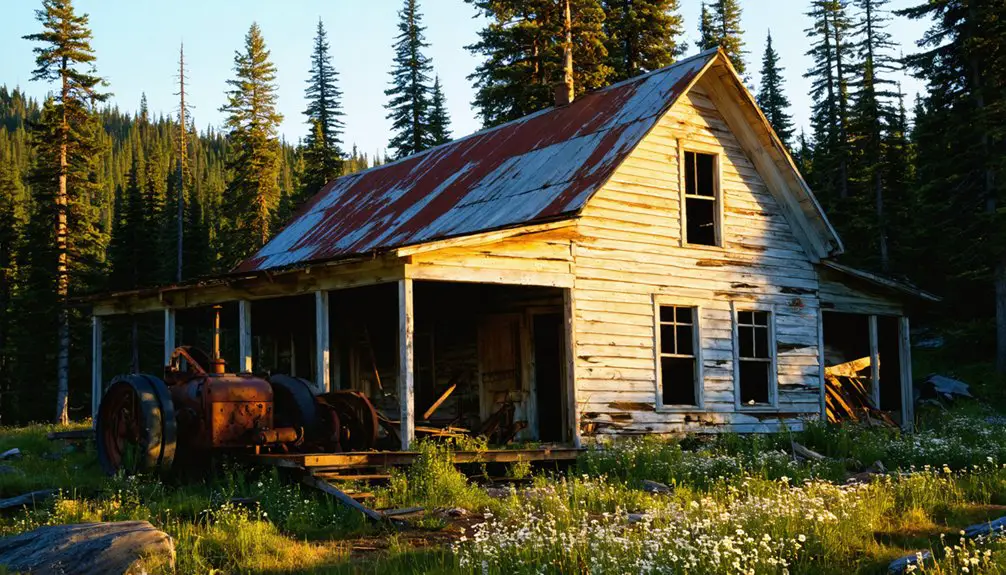You’ll discover Vader, Washington’s remarkable transformation from a booming industrial center to near ghost town and back. Once home to 5,000 residents during its late 1800s peak, this Lewis County settlement saw its population plummet below 400 as lumber and clay industries departed. Today, with 643 residents, preserved Victorian architecture, and a thriving historic district along A Street, Vader’s story reveals how a community’s embrace of its past can secure its future.
Key Takeaways
- Vader’s population plummeted from 5,000 during its industrial peak to below 400 during its ghost town period.
- The departure of major lumber and clay industries in 1913 triggered Vader’s decline toward ghost town status.
- Historic Victorian buildings, including the 1903 Olson House, remain as remnants of Vader’s prosperous past.
- The town has recovered from near-ghost town status, growing to 643 residents through preservation and economic revitalization efforts.
- Strategic improvements and historic preservation initiatives prevented complete abandonment and helped maintain Vader’s historic character.
The Rise and Fall of Little Falls
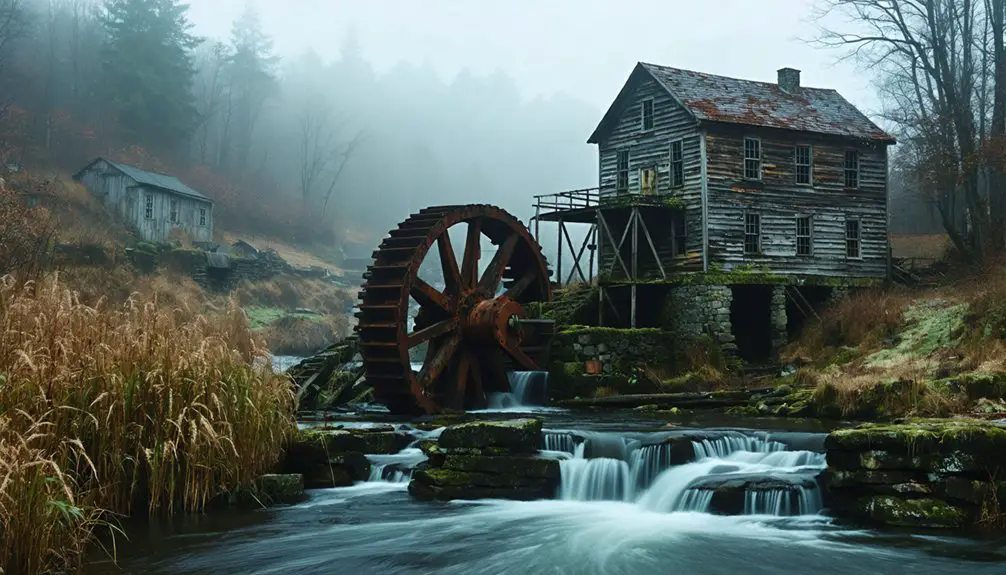
While Vader stands today as a quiet reminder of Washington’s boom-and-bust cycles, its origins trace back to the 1870s when it was first platted as Kraft, named after local postmaster Paul Kraft.
You’ll find its early identity took shape when the name changed to Little Falls, inspired by a waterfall on Olequa Creek. The town incorporated in 1906, with nearly unanimous support from its residents. The incorporation vote showed overwhelming local backing with 77 out of 78 votes in favor.
During its heyday, Little Falls was one of the largest settlements between Tacoma and Portland, driven by thriving lumber and clay industries. Much like nearby Sherman, the town’s fortunes declined as new roads led residents to seek opportunities in larger cities.
But economic shifts would soon reshape its destiny. The town’s final name change to Vader in 1913 marked a turning point, and as major industries departed, the community identity transformed from a bustling hub to a quiet reminder of the Pacific Northwest’s resource-dependent past.
Victorian Architecture’s Last Stand
You’ll find a resilient collection of Victorian homes in Vader, including the 1903 Olson House and 1895 Rose Hill House, standing as rare survivors from the town’s earliest days.
Local preservation groups like “Vader Old Houses Matter” work tirelessly to protect these architectural treasures through fundraising and community education initiatives.
These remaining Victorian structures, with their ornate woodwork and steep gabled roofs, serve as vital physical evidence of Vader’s prosperous logging-era past and contribute to the town’s distinctive “little New England village” character. Similar to Portland’s Theatre In the Grove, where historic architecture meets supernatural activity, some residents claim the old Victorian homes harbor their own mysterious presences.
Preservation Against All Odds
Despite its ghost town status, Vader has emerged as a remarkable example of Victorian architectural preservation, largely due to the dedicated efforts of private owners and community initiatives.
You’ll find preservation challenges being met head-on through the town’s extensive plan, which prioritizes Victorian homes as heritage resources. The community’s engagement is evident in development regulations that mandate period-appropriate commercial facades, maintaining the historic downtown’s character. Thorough historical research before visiting has helped identify key structures worth preserving.
Private owners, like those of the Ben Olsen House and Rose Hill House, have played vital roles in safeguarding these architectural treasures since the early 1900s. The Ben Olsen House stands as the town’s only Queen Anne style residence, making its preservation particularly significant.
While limited funding and harsh weather pose ongoing threats, Vader’s unique position as a ghost town with intact Victorian structures sets it apart. The town’s recent population growth and renewed interest in historic properties signal a promising future for these preserved landmarks.
Victorian Homes Still Standing
Vader’s Victorian treasures stand as living monuments to the town’s prosperous past, with five original homes from the 1890s still gracing its streets.
You’ll find the most impressive example in the Ben Olsen House, locally known as “The Mansion” – the town’s only Queen Anne-style residence and the first to have electricity.
Along A and B Streets, you’ll discover impeccable Victorian craftsmanship in the detailed wooden facades and intricate woodwork that showcase the town’s former wealth.
These homes, built during Vader’s industrial peak when the population reached 5,000, reflect the architectural significance of an era when sawmills and clay production drove the economy.
Today, these preserved Victorian gems continue drawing visitors and new residents, helping revitalize this historic community.
Restoration Efforts Take Root
While the grand Victorian homes stand as monuments to Vader’s gilded age, preserving these architectural treasures requires dedicated community action.
You’ll find residents like Costello leading the charge through personal restoration projects, combining traditional methods with modern DIY resources to breathe new life into historic structures.
Community engagement flourishes through initiatives like “Vader Old Houses Matter,” which unites homeowners in preservation efforts and promotes heritage tourism. Many residents are drawing inspiration from historical mining communities like Franklin, where immigrant families from Wales, England, Ireland, Italy and Scotland built thriving neighborhoods.
While funding remains scarce for official projects, opportunity sites along Olequa Creek offer promise for habitat restoration, including native plantings and channel improvements that could support environmental education.
Despite challenges like vandalism and limited resources, you’ll see determination in Vader’s preservation movement as residents work to protect both their architectural heritage and natural landscapes for future generations.
From Railroad Hub to Rural Haven
As railroads transformed the Pacific Northwest in the late 1800s, the small settlement of Little Falls evolved into a bustling hub that would later become Vader, Washington.
You’ll find a town that’s experienced dramatic shifts, from its railroad legacy of 5,000 residents to near abandonment in the 1960s, before discovering its modern rural charm.
Here’s how Vader transformed:
Experience Vader’s evolution from frontier settlement to modern small town – a journey of transformation spanning three centuries
- Population plummeted below 400 during its ghost town period, but has since rebounded to 643 residents.
- Victorian homes from the 1890s still grace the streets, with wooden facades required for new downtown buildings.
- The town’s attracted new residents with affordable properties and a “little New England village” atmosphere.
Today, you’ll discover a community that’s embraced its historic roots while fostering a peaceful rural lifestyle.
Early Business and Industry
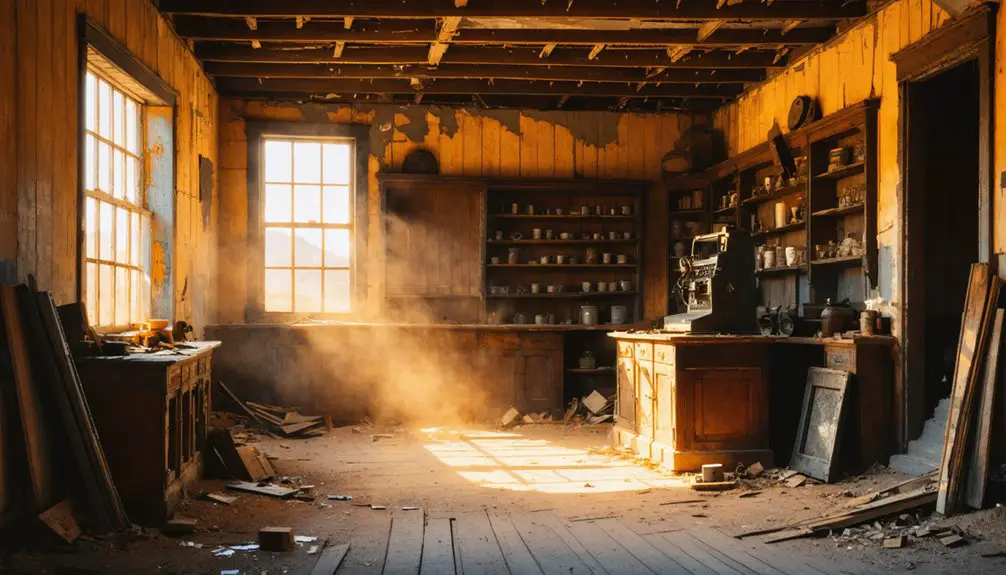
During the late 1800s, thriving lumber and clay industries transformed Little Falls into a powerhouse of Pacific Northwest commerce.
You’d have found multiple sawmills operating alongside clay production facilities, while the Stillwater Logging Company, led by Ben Olsen, stood as the town’s major employer. The lumber legacy extended beyond raw timber, with a sash and door factory complementing the industrial landscape.
You’ll appreciate how strategic positioning played an essential role in the town’s success. The Cowlitz River provided vital transportation, while connections to four major railroad lines guaranteed efficient distribution.
This industrial might, combined with the clay industry’s strength, made Little Falls the most prosperous settlement between Vancouver and Tacoma by the 1890s, supporting a population of 5,000 at its peak.
A Town’s Evolving Identity
Since its humble beginnings as Kraft, the town’s identity has undergone several transformations that mirror its economic fortunes.
Through cultural shifts and economic challenges, Vader’s community resilience shines in its ability to reinvent itself while preserving its historic character.
Vader’s enduring spirit lies in its remarkable ability to embrace change while keeping its small-town soul intact.
You’ll find evidence of this evolution in:
- The town’s name changes – from Kraft to Little Falls, and finally to Vader in 1913
- The preservation of Victorian architecture and wooden facades along A Street, maintaining the town’s “small New England village” charm
- Modern initiatives like wireless infrastructure improvements and downtown revitalization, showing the community’s commitment to progress while honoring its past
Today’s Vader balances its ghost town reputation with renewed growth, as affordable property values attract new residents seeking small-town authenticity.
Preservation Efforts and Modern Revival
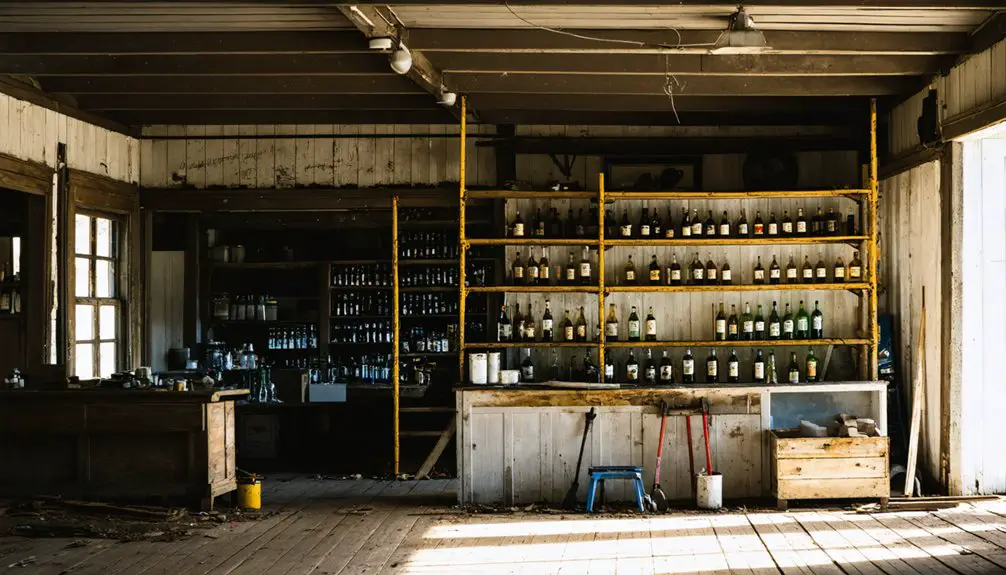
You’ll find Vader’s preservation efforts deeply rooted in its extensive plan, which mandates wooden facades along A Street and protects Victorian architectural elements that define the town’s historic character.
The community’s dedication to heritage conservation extends beyond buildings through initiatives like historic walking tours, McMurphy Park development, and centennial celebrations that strengthen local identity.
While maintaining its logging town aesthetic from 1910, Vader has balanced preservation with modern growth through strategic improvements like wireless connectivity and new housing developments that respect historical design guidelines.
Historic Building Restoration
Throughout Vader’s recent history, historic building restoration has played an essential role in preserving the town’s architectural heritage, with the Ben Olsen House standing as its crown jewel.
You’ll find this Queen Anne-style masterpiece exemplifies the historical significance of Vader’s early 20th-century prosperity, maintaining its architectural authenticity through careful preservation.
The town’s commitment to restoration is evident through:
- Strict development regulations requiring wooden facades on A Street that match the historic business district
- Private investment initiatives, like the $95,000 purchase and restoration of the Ben Olsen House in 1986
- Integration of modern functionality while preserving Victorian-era elements, guided by historic photographs and documentation
You’ll discover these preservation efforts have transformed Vader into a scenic small town that celebrates its turn-of-the-century charm, attracting both residents and tourists.
Community-Led Heritage Programs
While Vader’s architectural heritage stands as a reflection of its past, the town’s vibrant community-led programs have transformed this historic landscape into a living cultural experience.
You’ll find passionate residents championing preservation through heritage education initiatives, including walking tours and interpretive signage that bring the town’s Victorian-era stories to life.
Community storytelling takes center stage during heritage festivals and seasonal fairs, where locals don period costumes and open historic buildings for tours. Similar to the quiet exploration of Okanogan Country’s ghost towns, these events allow visitors to connect deeply with the area’s history. The site features well-maintained trails perfect for discovering the town’s hidden stories.
These events showcase local artisans and craftspeople who blend traditional motifs with contemporary expressions.
Through partnerships with preservation organizations and regional tourism entities, Vader has secured essential resources for its heritage programs.
This grassroots approach has helped grow the population from 400 to 643, proving that embracing historic charm can drive modern revival.
Economic Revitalization Strategy
By harmonizing historic preservation with modern development needs, Vader’s economic revitalization strategy has created a distinctive blueprint for small-town renewal.
You’ll find a carefully orchestrated approach that balances growth with heritage, focusing on the SR 506 corridor while maintaining the charm of historic A Street’s wooden facades and Victorian homes.
Key elements of community engagement and economic revival include:
- Strategic infrastructure development coordinated with preservation goals
- Business recruitment targeting cultural, educational, and recreational sectors
- Tourism initiatives showcasing historic landmarks and local events
You’re witnessing a transformation where historic preservation serves as more than aesthetics – it’s a core economic driver. The town’s efforts to avoid becoming another ghost town like Marianna Mine’s community in 1988 have shaped its preservation-focused development approach.
The town’s development regulations and thorough planning guarantee new growth complements rather than compromises Vader’s unique cultural identity.
Historical Landmarks and Lost Structures
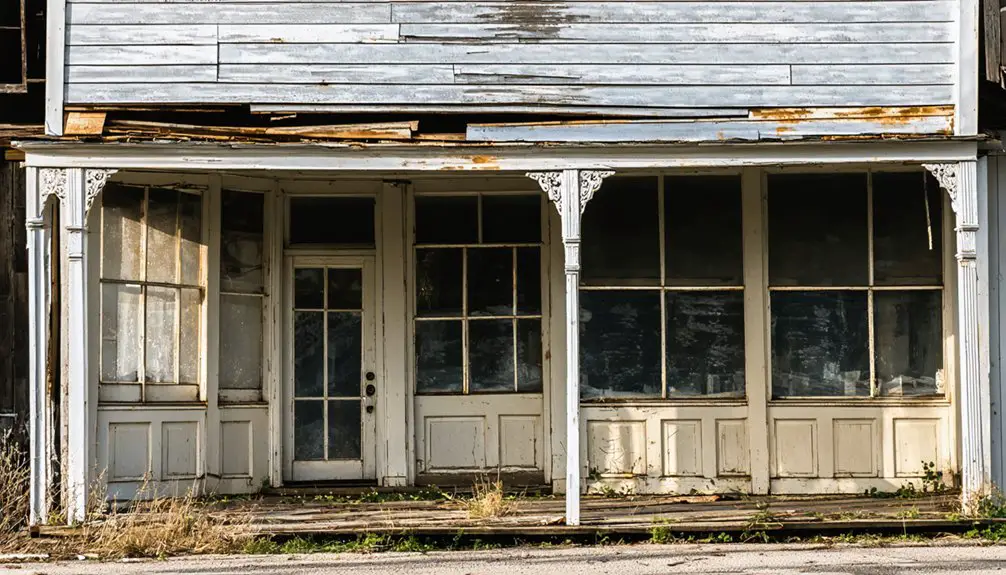
During Vader’s prosperous timber era, several notable structures emerged that exemplified the town’s architectural heritage, including the Ben Olsen House and Rose Hill House.
The Ben Olsen House, known locally as “The Mansion,” was the first residence with electricity and remains the town’s only Queen Anne-style building. You’ll find the Rose Hill House among just five surviving Victorian-era homes from the 1890s.
The historic Ben Olsen House and Rose Hill House stand as rare architectural treasures from Vader’s prosperous Victorian past.
Many lost landmarks tell the story of Vader’s decline from a bustling hub of 5,000 residents to a near ghost town.
The downtown’s architectural significance has faded, with its wooden sidewalks and opera house now gone. While some structures like the old jail still stand, most of the historic mills, rail depots, and timber industry buildings have vanished, leaving scattered remnants of the town’s glory days.
Life in Vader Through the Decades
As Little Falls in the late 1800s, Vader’s story began with a small settlement near the waterfalls of Olequa Creek before emerging as a thriving lumber town.
You’d find a bustling community where local folklore and community gatherings centered around the opera house, moving picture theater, and numerous saloons.
By 1920, the population soared to 5,000 residents enjoying a vibrant social scene.
- During the boom years, you could catch a show at the opera house, bowl at the local alley, or worship at one of two churches.
- The 1920s brought devastating fires and industrial decline, transforming the once-prosperous town.
- By the 21st century, you’ll find a smaller but resilient community of 629 residents working to preserve their heritage through historic walking tours and annual celebrations.
Frequently Asked Questions
What Caused the Unexplained Deaths in Vader During the Early 1900S?
Like a faded photograph, you won’t find evidence of unexplained deaths in Vader during that era. Historical records don’t support claims of mysterious illnesses or mass fatalities there in the 1900s.
Are There Any Remaining Native American Artifacts or Sites Near Vader?
You’ll find indigenous cultural heritage throughout the region, but specific Native American artifact locations aren’t publicly documented near Vader to protect remaining sites from unauthorized collection and disturbance.
What Happened to Martin Vader After the Town Was Named?
You’ll find that Martin Vader lived his final years at an Orting soldiers’ home until his death in 1935, leaving behind a legacy that’s more symbolic than substantial to the town’s development.
Did Any Famous Outlaws or Criminals Pass Through Vader?
Despite reviewing records of over 100 years of local history, you won’t find any famous outlaws or criminal activity documented in Vader, which remained primarily a peaceful logging and railroad town.
Were There Any Documented Paranormal Activities in Vader’s Abandoned Buildings?
You won’t find documented ghost sightings or paranormal activity in Vader’s abandoned buildings. Unlike other haunted locations in Washington state, there’s no official record of supernatural phenomena in this town.
References
- http://www.chronline.com/stories/vader-whats-in-a-name
- https://www.ezview.wa.gov/Portals/_1976/Documents/ElementExamples/Vader Comprehensive Plan.pdf
- http://www.chronline.com/stories/old-houses-matter-vader-woman-thinks-the-towns-past-could-be-key-to-the-communitys
- https://www.historylink.org/File/23303
- https://en.wikipedia.org/wiki/Vader
- https://stateofwatourism.com/ghost-towns-of-washington-state/
- https://www.youtube.com/watch?v=YNWs2U2_Tdk
- https://www.historylink.org/File/2537
- https://en.wikipedia.org/wiki/List_of_ghost_towns_in_Washington
- https://www.hauntedplaces.org/vader-wa/
